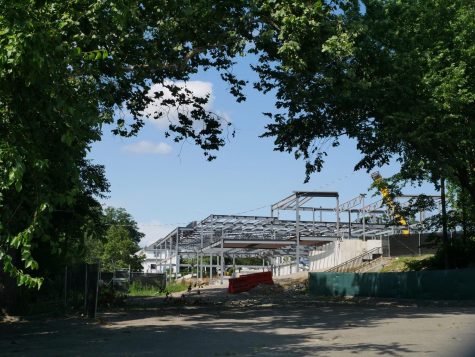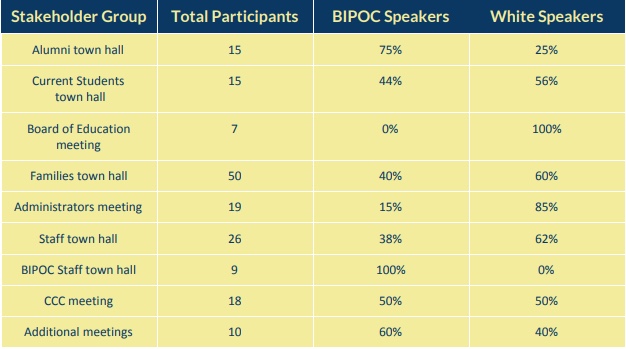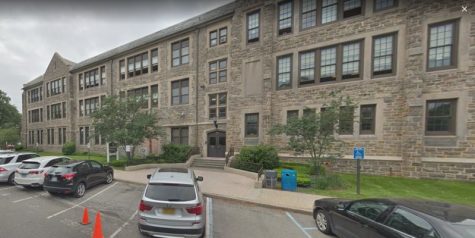Racial equity report: District lacks consistent commitment to ‘equitable and racially just’ schools
'Action must be intentional, thoughtful, responsive and vigilant...'
December 20, 2020

The Pelham school district’s racial equity consultants found the district lacks “a consistent commitment to fostering an equitable and racially just school environment,” citing disparities in the testing performance of white and nonwhite students and a deep need to diversify hiring. The group recommended a review of existing barriers to employment and the creation of “affinity spaces” for minority groups.
Study-author the Metropolitan Center for Research on Equity and the Transformation of Schools also outlined a need for clearer data collection systems in order to understand and address disparities, as well as a more equitable approach to making school resources accessible for students and families. It specifically suggested the district revisit the implementation of the Princeton Plan at the elementary level to better integrate younger students. The Princeton Plan, considered ten years ago, would eliminate the neighborhood elementary school system, instead populating the schools by grade.
According to the center, the audit is the first step in beginning to address “systems of inequity” and how they operate within the Pelham Union Free School District. When the Metro Center presented its preliminary findings in late October, the school board issued a statement saying it would work with the center “to develop a roadmap for addressing the recommendations.”
“In a community where harm runs deep, where communication and transparency have been questioned, and where there is a level of skepticism about ongoing efforts to this work, action must be intentional, thoughtful, responsive and vigilant in order to foster the equitable, inclusive and racially just environment to which Pelham students, especially those from the most marginalized and underrepresented identities, are entitled,” said the report.
In the 42-page preliminary report, the consultants said they relied on feedback from meetings and town halls as well as district-provided documents to analyze Pelham’s commitment to racial equity after they were hired this summer by the school board. Natalie McCabe Zwerger, director of the Metro Center’s Center for Strategic Solutions (CSS), and equity coach Cathlene Antoine-Abiala met with district leaders and community stakeholders over the summer. This effort followed the public response to George Floyd’s death and heightened racial tension in the spring, when Pelham community members held vigils and marches and expressed the desire for a proactive approach to racial justice by district administrators. Groups like Pelham United, a coalition of Pelham alumni, and Bridges of Pelham, founded by mothers of Black children in Pelham schools, spoke up about their own experiences as parents and students of color to encourage change. The voices of these stakeholders and others were prioritized in the audit process over the summer.

Academic Performance and Behavior
Focusing mainly on race as a factor, Pelham’s equity consultants reviewed reports of student academic performance and behavior in their analysis of existing disparities in the district. They found in the data that Black, indigenous and people of color (BIPOC) tended to underperform in state English Language Arts exams and were underrepresented in honors and AP classes at the high school level. Much of this latter disparity was the result of the lack of accessibility of educational resources in the district, as well as the varied treatment of students entering accelerated courses based on their racial identity, the report said.
The audit referenced data from the 2018-19 school year which showed low or decreased ELA proficiency rates from multiracial, Black and less economically advantaged students and an increase of one-percentage point in Latinx students. District data from 2016-18 was also reviewed: Black, Latinx, less economically advantaged and students with disabilities were shown to have underperformed the school average on the ELA and math assessments, which are given in third through eighth grades. According to the audit, the disparities were most acute at Hutchinson School, which serves “the greatest percentage of BIPOC and less economically advantaged students.”

At the secondary level, the district adopted an “open enrollment” policy in the 2017-18 school year, allowing students to take honors and AP courses regardless of their academic performance in previous years. Despite this, according to the report, “BIPOC representation in AP classes remains disportionately low.” This enrollment disparity is also reflected in middle school honors courses, where Black and Latinx student representation was low on a proportionate basis for the past two school years.
As for behavior, in nearly every year for the past five years, Black, Latinx and students with disabilities have been suspended at higher rates compared to their representation in the general student body.
In addressing these academic and behavioral disparities, the report recommended that Pelham leadership and staff attempt to analyze the issue at its core: “Pelham must conduct a root causal analysis to get to the foundation of these persistent disparities… Much of the data reviewed for this report can be utilized to begin the root causal analysis in the areas of achievement, suspension, AP/honors course enrollment and special education identification.”
The center went on to urge greater access to information regarding accelerated courses at the middle and high school level to ensure that students are aware of the prerequisite classes needed and are prepared for the increased workload that will be asked of them. Additionally, once students are able to access these courses on a more equitable level, the consultants recommended the schools provide “structural attention and support” to traditionally disadvantaged students.
Hiring
Metro Center explicitly called for the district to “diversify hiring and strengthen retention practices with the intention of growing and fostering affinity spaces available to BIPOC students, staff and families.”
The audit found a clear problem in the environment created by the current staff demographics in Pelham: “While the district student population is 66% white, the teaching staff is 91% white.” This lack of representation of minorities, the consultants said, hinders the district’s ability to embrace its commitment to cultural competence. According to the report, a more diverse staff would help students see themselves in successful roles and provide BIPOC students with staff members who may identify more closely with their race-related struggles in the school.
Though the report made the strong call to diversity the staff, new hiring processes were not explicitly outlined in the document. It did cover the need to improve the retention of minority educators through the prioritization of “affinity spaces.” The creation of these spaces would allow staff, students and families of shared identities and values to convene, which the report said was “essential for thriving, connecting and feeling the sense of belonging the district intends to foster.”
BIPOC affinity spaces should be prioritized in the future, particularly to ensure that staff members have access to a community that will allow them to feel safe and heard in order to “strengthen retention practices.”
Hutch and Segregation
Hutchinson School comes up again in a section of the report covering the “lingering effects of segregationist history” that “emerged as a theme across the narrative offered by community members. Many community members mentioned how this history played an active role in the current stereotypes and narratives that operate within school walls.”
McCabe Zwerger, the CSS director, clarified that this language referred to the “geographically constituted” separation of certain community groups within Pelham, which she said ultimately returns to the impact of racial division. Community members in the town halls reported how this history played an active role in the current stereotypes and narratives that operate within school walls.

In the audit, the consultants highlighted how the layout of the high school was part of the problem.
“In fact, PMHS is physically set up to maintain this segregation,” they wrote in the report. “The two entrances to the high school mirror the two economically different sides of Pelham—one on the north side, where there is less socioeconomic advantage, and one on the south side, which contains Pelham Manor, where there is more socioeconomic advantage.”
The report left out the fact that most of those who attended Colonial School, with the second highest percentage of white students in the district, also live to the north of the high school. No data exists on who actually uses the front door versus the Franklin Avenue entrance. The high school was built in 1920.
Zwerger said that the reported separation of the use of entrances serves as just one of the factors contributing to the stereotyping of Black and brown students as they enter the high school building. The sentiment was echoed by a BIPOC student in one of the Metro Center’s forums: “We need to talk about what happens in Pelham. Kids are racially profiled.”
One proposed solution from the CSS for the problem of geographic segregation was to resurrect the Princeton Plan. This program would attempt to eliminate the racial division created by neighborhood schools, which is to say, the difference at Hutch (41% white) versus the other three elementary schools (70% to 75% white). Under the plan, the elementary student body would be divided by age, with each building teaching students of certain grades from all over town. Previous discussion of the plan’s implementation in Pelham received significant backlash, as several community members recalled in the Metro Center’s meetings.
“Those of us who were in the district about 10 years ago remember the discussions around the Princeton Plan,” said a parent at one of the forums. “It was so distressing to hear the barely veiled and not at all veiled racism expressed by parents in that time. There was huge resistance from some parents to having their kids mix with ‘those kids.'”
Other suggestions included one parent recommending organizing elementary sports teams across buildings rather than by school, while another criticized the ballroom dancing program at Hutch for “reinforcing gender norms” in young children.
The construction of the new building for Hutchinson also came up, with the study’s commentary weighted toward reported opposition to the project and the racial implications of that opposition. One “white administrator” said there was “significant pushback” to the project, Metro Center said.
However, a school board member told the CSS, “It was one of the largest long propositions that we have ever put in front of a community, and it was very clearly weighted onto a particular side of town with more diversity than the rest of Pelham. I remember being really really worried that the town wasn’t going to come behind the school because of where it was located… but it didn’t go that way. So I think that that’s a real testament to how the thinking has changed over the years and how people really do see it as one community.”
The $53 million Hutchinson bond proposition passed by a significant margin, 1,584 to 698. The budget that year was adopted 1,723-550.
Elizabeth Dorgan • Jul 17, 2021 at 12:42 pm
Societies problems play themselves out within the walls of public schools with a
magnifying glass.
Karin Bratone • Dec 20, 2020 at 7:23 pm
excellent investigative piece and superb writing.
Congrats to the author and the paper.
Syd Thayer • Dec 20, 2020 at 6:18 pm
Sophia. This is a wonderful summary of the report. Fair and balanced reporting by you on an issue frought with controversy. I have printed the full report thanks to you providing the link and plan to read and digest As you conclude, I am proud of our community’s support of the Hutch construction and the following year’s budget. We are a great community searching for an evolving solution. I see this in the positive. Thank you.
Toby Marxuach-Gusciora • Dec 20, 2020 at 12:37 pm
Very well written article and informative. Thank you Sophia
Liz Massie • Dec 18, 2020 at 11:43 pm
Fantastic piece, Sophia! Reported thoroughly and effectively. Thank you!
Claire Persanis • Dec 18, 2020 at 6:09 pm
Thanks Sophia for this thorough article. Well done.
matt persanis • Dec 18, 2020 at 6:03 pm
Anyone looking at the class photos every year can see the segregation. If you look at the map of the school catchment areas you can see the map for Hutchinson is drawn to specifically include apartment buildings and exclude certain single family neighborhoods. I think more important than race is the socioeconomic diversity. These issues have been brought up for many years, but ignored.
Kathryn Alexander • Dec 18, 2020 at 3:33 pm
Thank you for this Sophia!